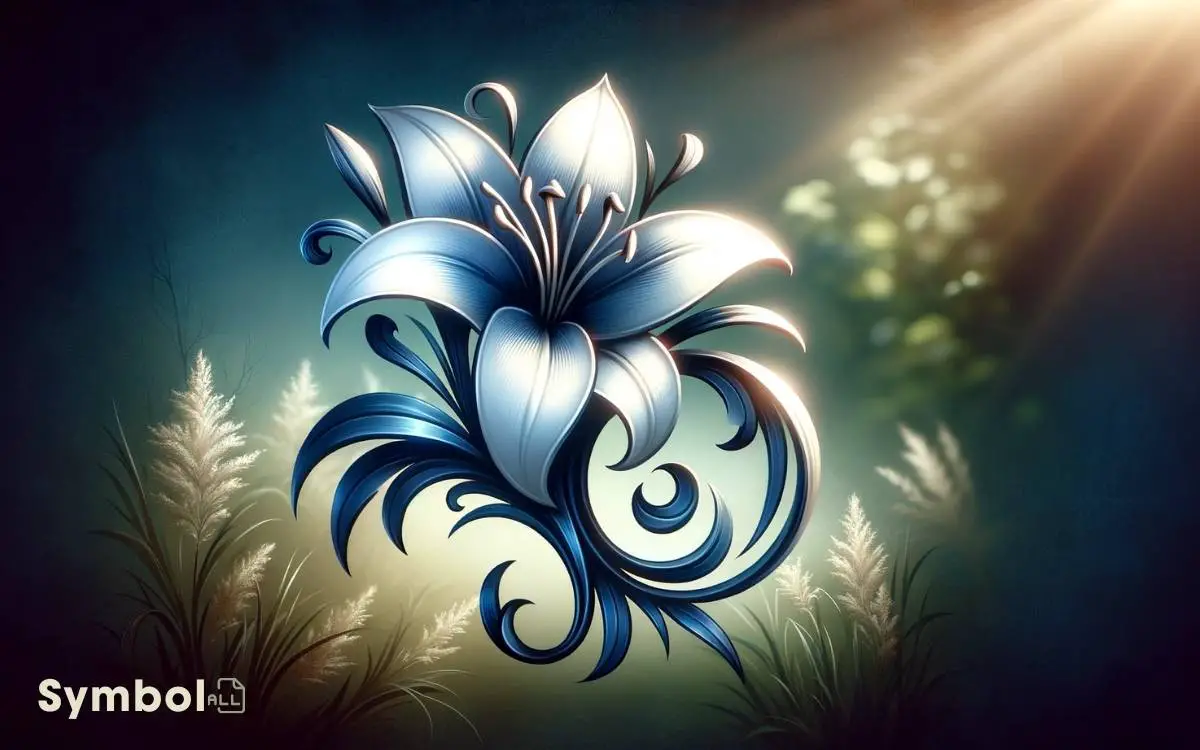Flower of the Lily Symbol: Purity, Rebirth!
The lily’s symbolism, tracing back to ancient civilizations, including Egypt around 1580 B.C., reflects a deep historical and cultural resonance.
It’s often conflated with the fleur-de-lis, especially after its adoption by French royalty, symbolizing purity, rebirth, and nobility.
In religious contexts, this flower denotes purity and martyrdom, representing significant biblical virtues. Across cultures, its meanings vary, but universally, it signifies innocence and rebirth.
Its depiction spans from medieval manuscripts to modern heraldry, embodying societal values and virtues.
Additionally, in military and heraldic contexts, it denotes unity and victory. Its symbolism evolves, reflecting changing societal ideals, ensuring its relevance through generations. This exploration only skims the surface of its intricate symbolism.

Key Takeaways
Historical Origins
The lily, with its long history steeped in symbolism and significance, has captivated human cultures across the globe for centuries.
You’ll find its roots deeply embedded in ancient civilizations, where it was revered not just for its beauty but for its perceived sacredness.
Tracing back to the Minoan civilization in Crete, evidence suggests the lily was symbolically significant as early as 1580 B.C.
This reverence continued in ancient Egypt, symbolizing fertility and purity, evident in tomb paintings and ceremonial garlands.
The Greeks and Romans adopted the lily, intertwining it with their own myths, associating it with Hera and Venus respectively.
This flower’s historical journey reveals a fascinating evolution, from sacred emblem to a ubiquitous symbol in various cultures, underscoring its enduring allure and significance.
Symbolism and Meanings
Delving into the symbolism and meanings of the lily, you’ll discover a rich tapestry that interweaves various cultural, religious, and emotional significances attributed to this enchanting flower.
This analysis reveals the lily’s multifaceted symbolisms across different contexts.
| Culture/Context | Symbolism | Meaning |
|---|---|---|
| Ancient Greece | Hera’s milk | Purity, rebirth |
| Christianity | Virgin Mary | Innocence, purity |
| Funerals | Departed souls | Restoration of innocence |
In ancient Greece, the myth of Hera’s milk spilling across the sky forming the Milky Way, and droplets on earth becoming lilies, symbolizes purity and rebirth.
Christianity associates the lily, especially the white lily, with the Virgin Mary, representing innocence and purity.
During funerals, lilies symbolize the soul’s return to a state of innocence. This detailed analysis underscores the lily’s profound symbolism across various spheres.
Connection to French Royalty
You’ll find that the lily’s association with French royalty traces back to its adoption as a royal emblem, a decision steeped in both political and religious symbolism.
This emblem, often mistaken for a fleur-de-lis, represented purity, power, and the divine right of kings, weaving a complex narrative of monarchy and faith.
Exploring the origins and symbolism within the monarchy reveals a multifaceted relationship between the lily and the cultural identity of France.
Royal Emblem Origins
Historically, French royalty adopted the lily as an emblem, signifying purity and power, to cement their divine right to rule.
This choice wasn’t arbitrary; it was steeped in a complex interplay of religious symbolism and political strategy.
The lily, or fleur-de-lis, has roots in ancient civilizations but gained prominence in France during the medieval period. Its adoption by French kings was a calculated move, designed to intertwine their lineage with the sanctity and authority of the Christian faith.
This emblem wasn’t just a decorative motif; it was a potent symbol of the monarchy’s unassailable position, ordained by divine will.
Its presence on shields, banners, and royal decrees served as a constant reminder of the monarchy’s hegemony, grounded in both spiritual sanctity and temporal power.
Symbolism in Monarchy
Building on the understanding of the lily as a symbol of purity and power within French royalty, it’s important to examine how this emblem, and others like it, bolstered the monarchy’s legitimacy and authority through intricate symbolism.
The lily’s representation wasn’t arbitrary; rather, it was a calculated choice, reflecting virtues and ideals the monarchy wished to project. This adoption of floral symbolism served a dual purpose.
To begin with, it visually communicated the divine right and benevolent governance of the rulers, anchoring their power in both religious and natural imagery.
Additionally, it reinforced the monarchy’s identity, distinguishing French kingship with an emblem that became synonymous with its heritage.
Through such symbolism, the lily transcended mere decoration, embodying the essence of French monarchical power and purity.
Religious Significance
You’ll find the lily’s presence in religious contexts isn’t arbitrary; it’s deeply rooted in symbolism and history.
Biblical representations often associate lilies with purity and the divine, serving as metaphors in key scriptures.
Similarly, saints’ emblematic use of the lily underscores its role in signifying virtue and sanctity, further cementing its spiritual significance.
Biblical Representations
In examining the biblical representations of the lily, one finds a symbol deeply embedded with themes of purity, renewal, and divine love, reflecting its significant religious importance throughout scripture.
This flower’s portrayal isn’t merely ornamental but deeply allegorical, serving as a metaphorical bridge between the divine and the earthly.
Within the texts, the lily is often associated with the Virgin Mary, symbolizing her immaculate purity and her role as the mother of Jesus, thereby linking the flower to concepts of spiritual rebirth and redemption.
Additionally, the lily’s frequent appearances in parables and descriptions of the promised paradise underscore its embodiment of divine beauty and the hope of salvation.
Through careful analysis, the lily emerges as a potent symbol of spiritual purity, divine favor, and eternal life, underscoring its enduring significance in biblical literature.
Saints Emblematic Use
Beyond its biblical representations, the lily also holds profound emblematic significance in the hagiographies of various saints, symbolizing virtues such as purity, devotion, and martyrdom.
This symbolism isn’t arbitrary but deeply ingrained in the narratives and iconography associated with these saints.
The lily’s association with these virtues can be seen in:
- Saint Anthony of Padua, where the lily signifies purity and his devotion to the Virgin Mary.
- Saint Joseph, depicted with a lily to symbolize his chastity and purity in his role as the Earthly father of Jesus.
- Saint Catherine of Siena, embodying the lily’s purity and her mystical marriage to Christ.
- Saint Dymphna, where the lily represents her martyrdom and purity in the face of adversity.
These examples underscore the lily’s emblematic use, enriching our understanding of its religious significance.
Global Variations
Why do lilies carry diverse meanings across different cultures, reflecting a rich tapestry of symbolism and significance?
This question invites an in-depth exploration into the myriad interpretations that vary from one region to another.
In Eastern traditions, the lily often symbolizes purity and renewal, resonating with spiritual and philosophical beliefs.
Conversely, European narratives might imbue the lily with attributes of royalty and nobility, stemming from historical associations with monarchies.
Additionally, in some cultures, lilies are intertwined with mourning and remembrance, signifying the transience of life.
These global variations aren’t arbitrary but are deeply rooted in historical, geographical, and cultural contexts.
They reveal how a single symbol can encapsulate a spectrum of meanings, each reflecting the unique ethos of a community.
In Heraldry and Coats of Arms
You’ll find the lily’s presence in heraldry and coats of arms isn’t merely decorative but steeped in historical significance and layered with symbolic meanings.
Its origins trace back to ancient civilizations where it symbolized purity, nobility, and renewal, aspects that were keenly adopted by European heraldry to convey identity and values.
In modern contexts, these symbols persist, evolving in usage while retaining their core significance, thereby offering a rich tapestry for analysis.
Historical Origins
The lily, emblematic of purity and virtue, has found its historical origins deeply rooted in heraldry and coats of arms, symbolizing nobility and heraldic tradition across various cultures. This connection isn’t accidental but is steeped in a history that traces back to ancient civilizations.
The usage of the lily, specifically the fleur-de-lis, as a heraldic symbol, offers insight into its enduring legacy and significance.
- The fleur-de-lis appears in the earliest known coats of arms, symbolizing royalty and authority.
- Its adoption by the French monarchy further cemented its association with leadership and purity.
- Crusaders often bore the symbol, linking it to religious and military undertakings.
- Various European cities and noble families incorporated the lily into their emblems, underscoring its widespread heraldic appeal.
This deep historical embedding showcases the lily’s enduring symbolic power in heraldic traditions.
Symbolic Meanings
Delving into the lily’s symbolic meanings within heraldry and coats of arms reveals a rich tapestry of virtues and ideals that these emblems historically conveyed.
The lily, often stylized as a fleur-de-lis, embodies purity, chastity, and virtue qualities highly esteemed in medieval society. Its appearance on a shield or banner wasn’t merely decorative; it signified a bearer’s commitment to uphold these lofty principles.
In addition, the lily’s association with the Virgin Mary added a layer of divine grace and protection, suggesting that the wearer was under the special favor of the heavens.
Analyzing these symbols, you uncover not just personal or familial identities but also a broader narrative of societal values, religious beliefs, and the intertwining of the sacred with the martial.
Modern Usage
In modern heraldry and coats of arms, the lily continues to signify nobility and purity, echoing its historical roots while adapting to contemporary contexts.
This emblem, often stylized as the fleur-de-lis, not only preserves its traditional meanings but also evolves to represent new values and associations.
You’ll find its application spans a broad spectrum, from personal family crests to the insignias of global institutions.
Key aspects of its modern usage include:
- Symbolizing purity and light in civic emblems
- Denoting rank and authority in military insignias
- Representing peace and unity in international symbols
- Serving as a motif in corporate logos and branding
This multifaceted symbol demonstrates a remarkable ability to transcend its medieval origins, embodying both age-old virtues and modern ideals with equal grace.
Artistic Representations
Artists have long incorporated the lily into their works, imbuing this elegant flower with layers of symbolic meaning that resonate deeply across cultures and epochs. In the domain of painting, the lily often symbolizes purity, love, and transcendence.
Analyzing medieval manuscripts, you’ll find lilies adorning the pages, each petal a confirmation to the divine.
Sculptures, too, haven’t escaped the lily’s influence; from ancient stone carvings to contemporary installations, the flower’s form and symbolism are reinterpreted, reflecting societal values and artistic movements.
This multifaceted symbol’s journey through art history underscores its enduring appeal and versatility.
As you explore these artistic representations, you’re invited to appreciate not just the lily’s beauty, but also the profound cultural and spiritual narratives it carries.
Military Emblems and Medals
The lily’s emblematic presence extends beyond the world of art, embedding itself into military emblems and medals as a symbol of honor, courage, and sacrifice.
This transformative use underscores the versatility and profound significance of the lily symbol across cultures and eras.
In military contexts, the lily often signifies:
- Purity of intent amidst the complexities of warfare.
- Unity among soldiers, transcending individual backgrounds.
- Resilience in the face of adversity and challenge.
- Victory over opposition, not just in battle but in maintaining ethical standards.
This incorporation into military insignias and awards demonstrates the lily’s enduring relevance and adaptability. It’s a confirmation to the flower’s ability to convey complex ideas of valor, purity, and unity, resonating deeply with those who serve.
Modern Usage and Interpretations
Today’s cultural landscape sees the lily symbol evolving, reflecting complex modern values and societal shifts with precision and nuance.
As you explore further, it’s clear that the lily’s significance extends beyond its historical religious and royal connotations.
In contemporary contexts, it embodies themes of purity, renewal, and transformation, resonating with global movements advocating for environmental sustainability and personal growth.
Scholars analyze its recurrence in digital media, branding, and social movements, highlighting how its symbolism is adapted to convey messages of hope and resilience.
This adaptability speaks to the lily’s enduring relevancy, as it seamlessly integrates into the fabric of modern culture, offering a multifaceted lens through which to explore current issues and aspirations.
Your understanding of its significance is enriched by recognizing these layers of contemporary interpretation.
Controversies and Criticisms
Despite its widespread symbolism of purity and renewal, the lily hasn’t been immune to controversy and criticism, reflecting deeper societal tensions and debates.
The controversies surrounding the lily often revolve around its use and representation in various cultural, religious, and political contexts, which may sometimes overshadow its natural beauty and significance.
- Cultural Appropriation: Questions have been raised about the ethical implications of using the lily in contexts far removed from its original cultural significance.
- Religious Sensitivities: Its use in religious imagery has occasionally led to debates over secularism versus sacred symbols in public spaces.
- Political Symbolism: The lily’s adoption by certain political movements or regimes has sparked discussions on the neutrality of symbols.
- Commercial Exploitation: Concerns exist regarding the environmental and ethical consequences of commercializing the natural beauty of lilies for profit.
These controversies highlight the complex interplay between nature, culture, and ethics in the interpretation of symbols.
Preservation and Conservation
Understanding the significance of lilies in various cultural and natural landscapes necessitates a dedicated focus on their preservation and conservation efforts.
As you explore this domain, it becomes apparent that safeguarding these symbols involves more than mere admiration; it’s about actively engaging in practices that guarantee their survival and continued relevance.
This entails combating habitat destruction, addressing climate change impacts, and fostering sustainable cultivation methods.
You’ll find that conservationists and cultural historians alike emphasize the need for all-encompassing strategies that encompass both in-situ and ex-situ conservation measures.
The Future of the Fleur-de-Lis
As we analyze the ongoing efforts to preserve the lily, it’s important to contemplate the evolving role and significance of the Fleur-de-Lis in contemporary society and its potential pathways forward.
This emblem, steeped in history, faces a future where its relevance could either flourish or wane.
Key considerations include:
- Adaptation to modern design and aesthetics
- Integration into contemporary cultural and political symbols
- Preservation efforts in historical and natural contexts
- Evolving interpretations and meanings within diverse communities
These facets underscore the dynamic nature of the Fleur-de-Lis’s symbolism. As society progresses, the emblem’s ability to adapt while retaining its historical essence will determine its longevity and continued resonance.
This evolution isn’t just about preservation but about meaningful engagement with the present and future.
Conclusion
The fleur-de-lis embodies a legacy steeped in history, symbolizing purity, power, and piety. Its roots deeply entwined with French royalty, it also carries significant religious connotations and has found diverse interpretations globally.
Modernity sees it adapting, yet controversies challenge its past uses. Efforts towards its preservation underscore its enduring appeal, suggesting its future will continue to unfold in complex ways.
Analyzing the fleur-de-lis reveals a symbol rich in meanings, embodying cultural depth across time and space.






